2015 MERCEDES-BENZ SLS AMG GT ROADSTER charging
[x] Cancel search: chargingPage 6 of 290

1, 2,
3...
12 Vsocket
see Sockets
4ETS (Electronic Traction System) .... 55A
ABS (Anti-lock Braking System) Display message ............................ 165
Function/notes ................................ 54
Warnin glamp .................................1 92
Activating/deactivating cooling
with air dehumidification ................. 108
ADAPTIVE BRAKE ................................. 57
Additional speedometer ................... 158
Additives (engine oil) ........................ 284
Adjustin glumbar support .................. 86
Airb ags
Display message ............................ 171
Front airb ag (driver, front
passenger )....................................... 40
Head bag ......................................... 42
Important safety notes .................... 38
Knee bag .......................................... 41
PASSENGER AIR BAG OFF indica-
tor lamp .......................................... .42
Safety guideline s............................. 37
Sid eimpact ai rbag .......................... 41
Air-conditioning system
see Climate control
Ai rf ilter (display message) .............. 180
AIRSCARF Switching on/of f.............................. 88
AIRSCARF vents
Setting the blower outpu t.............. 114
Ai rv ents
Important safety notes .................. 113
Setting ........................................... 113
Setting the blower outpu tofthe
AIRSCAR Fvents ............................. 114
Setting the center ai rvents ........... 114
Setting the sid eairvents ............... 114
Switching AIRSCAR Fon/of f............ 88
Alarm system
see ATA (Anti-Theft Alarm system) AMG
Adaptive sport suspensio nsystem .. 140
Butto nfor AMG menu .................... 128
E-SELECT lever .............................. 121
Menu (on-board computer) ............ 160
SETUP ............................................ 128
SPEEDSHIFT DCT 7-gear sport
transmissio n.................................. 121
Anti-loc kbraking system
see ABS (Anti-lock Braking System)
Anti-Theft Alarm system
see ATA (Anti-Theft Alarm system)
Ashtray ............................................... 203
ASSYST PLUS servic einterva ldis-
play Hiding service messages ............... 222
Service messages .......................... 222
ATA (Anti-Thef tAlarm system)
Activating/deactivating ................... 58
Function ........................................... 58
Switching off the alarm .................... 58
Audi omenu( on-board computer) .... 154
Audi osystem
see separate operating instructions
Authorized Mercedes-Benz Center
see Qualifie dspecialist workshop
Authorized workshop
see Qualifie dspecialist workshop
AUTO lights
Displa ymessage ............................ 174
Automatic headlamp mode ................ 96
Automatic transmission Overview ........................................ 121 B
BAS (Brake Assist System) ................. 55
Battery Displa ymessage ............................ 185
Battery (SmartKey)
Checking .......................................... 65
Important safety notes .................... 64
Replacing ......................................... 65
Battery (vehicle)
Charging ........................................ 240
Displa ymessage ............................ 178 4
Index
Page 101 of 290
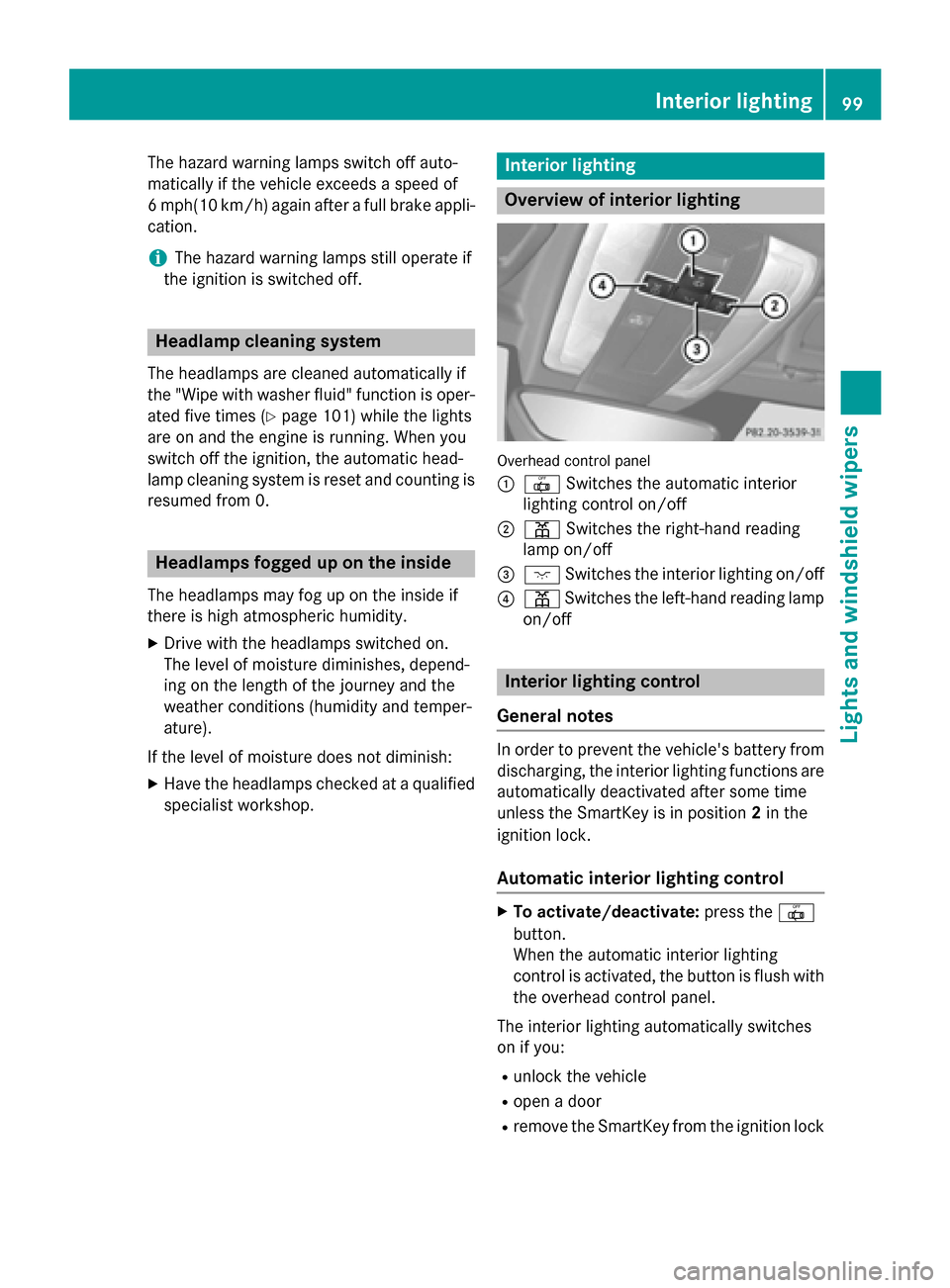
The hazard warning lamps switch off auto-
matically if the vehicle exceeds aspeed of
6m ph(10 km/h) again after afull brake appli-
cation.
i The hazard warning lamps still operate if
the ignition is switched off. Headlam
pcleaning system
The headlamps are cleaned automatically if
the "Wipe with washer fluid" function is oper-
ated five times (Y page 101) while the lights
are on and the engine is running. When you
switch off the ignition ,the automatic head-
lamp cleaning system is reset and counting is
resumed from 0. Headlamps fogged up on the inside
The headlamps may fog up on the inside if
there is high atmospheric humidity.
X Drive with the headlamps switched on.
The level of moisture diminishes, depend-
ing on the length of the journey and the
weather conditions (humidity and temper-
ature).
If the level of moisture does not diminish:
X Have the headlamps checked at aqualified
specialist workshop. Interior lighting
Overview of interior lighting
Overhead control panel
0043
0033 Switches the automatic interior
lighting control on/off
0044 003D Switches the right-hand reading
lamp on/off
0087 004A Switches the interior lighting on/off
0085 003D Switches the left-hand reading lamp
on/off Interior lighting control
General notes In order to prevent the vehicle's battery from
discharging, the interior lighting functions are
automatically deactivated after some time
unless the SmartKey is in position 2in the
ignition lock.
Automatic interior lighting control X
To activate/deactivate: press the0033
button.
When the automatic interior lighting
control is activated, the button is flush with
the overhead control panel.
The interior lighting automatically switches
on if you:
R unlock the vehicle
R open adoor
R remove the SmartKey from the ignition lock Interior lighting
99Lights and windshield wipers Z
Page 136 of 290
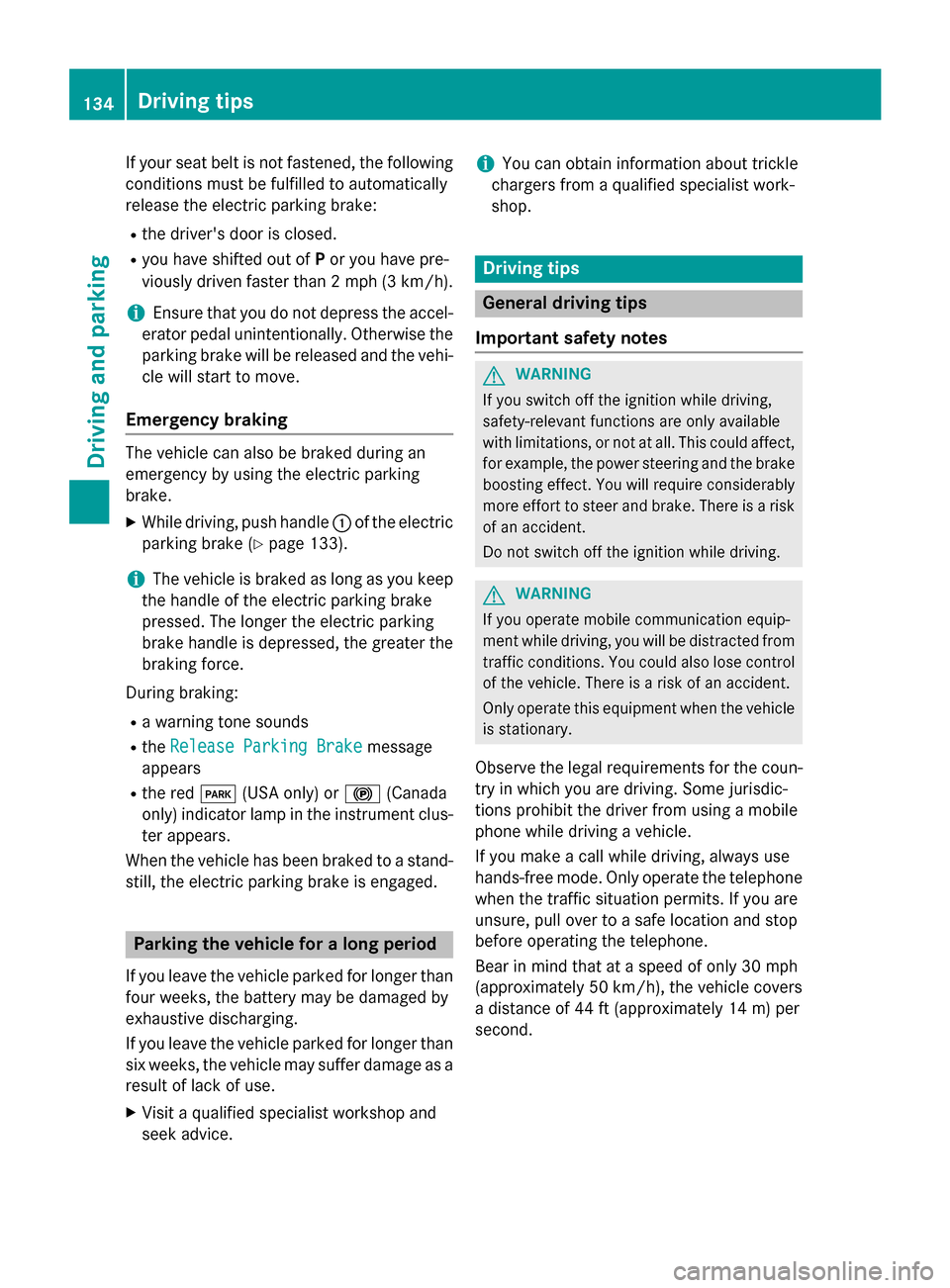
If yours
eat belt is not fastened, the following
conditions must be fulfilled to automatically
release the electric parking brake:
R the driver's door is closed.
R you have shifted out of Por you have pre-
viously driven faster than 2mph (3 km/h).
i Ensure that you do not depres
sthe accel-
erator pedalu nintentionally.Otherwise the
parking brake willber eleased and the vehi-
cle wills tart to move.
Emergency braking The vehicle can also be braked during an
emergency by using the electric parking
brake.
X Whiled riving, push handle 0043of the electric
parking brake (Y page 133).
i The vehicle is braked as long as you keep
the handle of the electric parking brake
pressed .The longer the electric parking
brake handle is depressed, the greater the
braking force.
During braking:
R aw arning tone sounds
R the Release Parking Brake
Release Parking Brake message
appears
R the red 0049(USA only) or 0024(Canada
only) indicator lamp in the instrument clus- ter appears.
When the vehicle has been braked to astand-
still, the electric parking brake is engaged. Parking the vehicle for
alon gp eriod
If you leave the vehicle parked for longer than
four weeks, the battery may be damaged by
exhaustive discharging.
If you leave the vehicle parked for longer than
six weeks, the vehicle may suffer damage as a resultofl ack of use.
X Visit aqualified specialist workshop and
seek advice. i
You can obtain information aboutt
rickle
chargers from aqualified specialist work-
shop. Driving tips
General driving tips
Important safety notes G
WARNING
If you switch off the ignition whiled riving,
safety-relevant functions are only available
with limitations, or not at all.T his could affect,
for example ,the powers teering and the brake
boosting effect. You willr equire considerably
more effort to steer and brake. There is arisk
of an accident.
Do not switch off the ignition whiled riving. G
WARNING
If you operate mobilec ommunication equip-
ment whiled riving, you willbed istracted from
traffic conditions. You could also lose control of the vehicle .There is arisk of an accident.
Only operate this equipment when the vehicle is stationary.
Observe the legalr equirements for the coun-
try in which you are driving. Some jurisdic-
tions prohibit the driver from using amobile
phone whiled rivingavehicle.
If you make acall whiled riving, alwaysu se
hands-free mode. Only operate the telephone
when the traffic situation permits. If you are
unsure, pullo ver toasafe location and stop
before operating the telephone.
Bear in mind that at aspeed of only 30 mph
(approximatel y50km/h), the vehicle covers
ad istance of 44 ft (approximatel y14m )per
second. 134
Driving tipsDriving and parking
Page 241 of 290
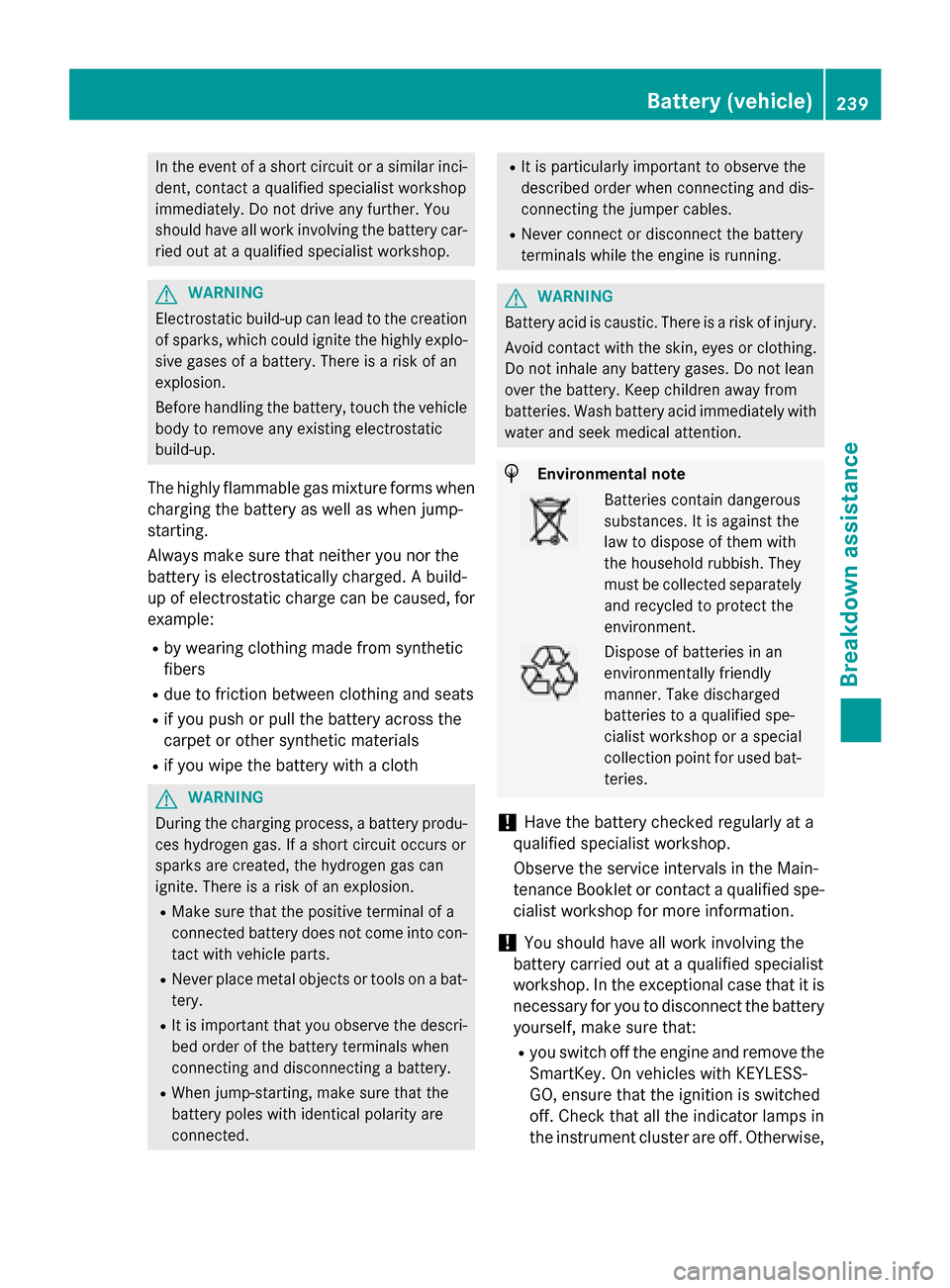
In the event of
ashort circuit or asimilar inci-
dent, contact aqualifieds pecialist workshop
immediately.Don ot drive any further. You
shouldh ave all work involving the battery car-
ried out at aqualifieds pecialist workshop. G
WARNING
Electrostatic build-up can leadtot he creation
of sparks, which could ignite the highlye xplo-
sive gases of abattery. There is arisk of an
explosion.
Before handling the battery, touch the vehicle body to remove any existing electrostatic
build-up.
The highlyf lammable gas mixture forms when
charging the battery as wellasw hen jump-
starting.
Alwaysm ake sure that neither you nor the
battery is electrostatically charged. Abuild-
up of electrostatic charge can be caused, for
example:
R by wearing clothing made from synthetic
fibers
R due to friction betwee nclothing and seats
R if you push or pullt he battery across the
carpet or other synthetic materials
R if you wipet he battery with acloth G
WARNING
During the charging process, abattery produ-
ces hydrogen gas. If ashort circuit occurs or
sparks are created, the hydrogen gas can
ignite. There is arisk of an explosion.
R Make sure that the positive terminal of a
connected battery does not come into con- tact with vehicle parts.
R Never place metal objects or tools on abat-
tery.
R It is important that you observe the descri-
bed order of the battery terminals when
connecting and disconnecting abattery.
R When jump-starting, make sure that the
battery polesw ith identical polarity are
connected. R
It is particularly important to observe the
describe dorder when connecting and dis-
connecting the jumper cables.
R Never connect or disconnect the battery
terminals whilet he engine is running. G
WARNING
Battery acid is caustic. There is arisk of injury.
Avoid contact with the skin, eyes or clothing.
Do not inhalea ny battery gases.Don ot lean
over the battery. Keep childre nawayfrom
batteries. Wash battery acid immediately with water and seek medica lattention. H
Environmental note Batteries contain dangerous
substances. It is against the
law to dispose of them with
the household rubbish. They
must be collected separately
and recycled to protect the
environment. Dispose of batteries in an
environmentally friendly
manner. Take discharged
batteries to
aqualifieds pe-
cialist workshop or aspecial
collection point for used bat- teries.
! Have the battery checked regularly at a
qualified specialist workshop.
Observe the service intervals in the Main-
tenance Booklet or contact aqualified spe-
cialist workshop for more information.
! You shouldh
ave all work involving the
battery carried out at aqualified specialist
workshop. In the exceptional case that it is
necessary for you to disconnect the battery yourself, make sure that:
R you switch off the engine and remove the
SmartKey. On vehicle swith KEYLESS-
GO, ensure that the ignition is switched
off. Check that all the indicator lampsin
the instrument cluster are off. Otherwise, Battery (vehicle)
239Breakdownassistance Z
Page 242 of 290
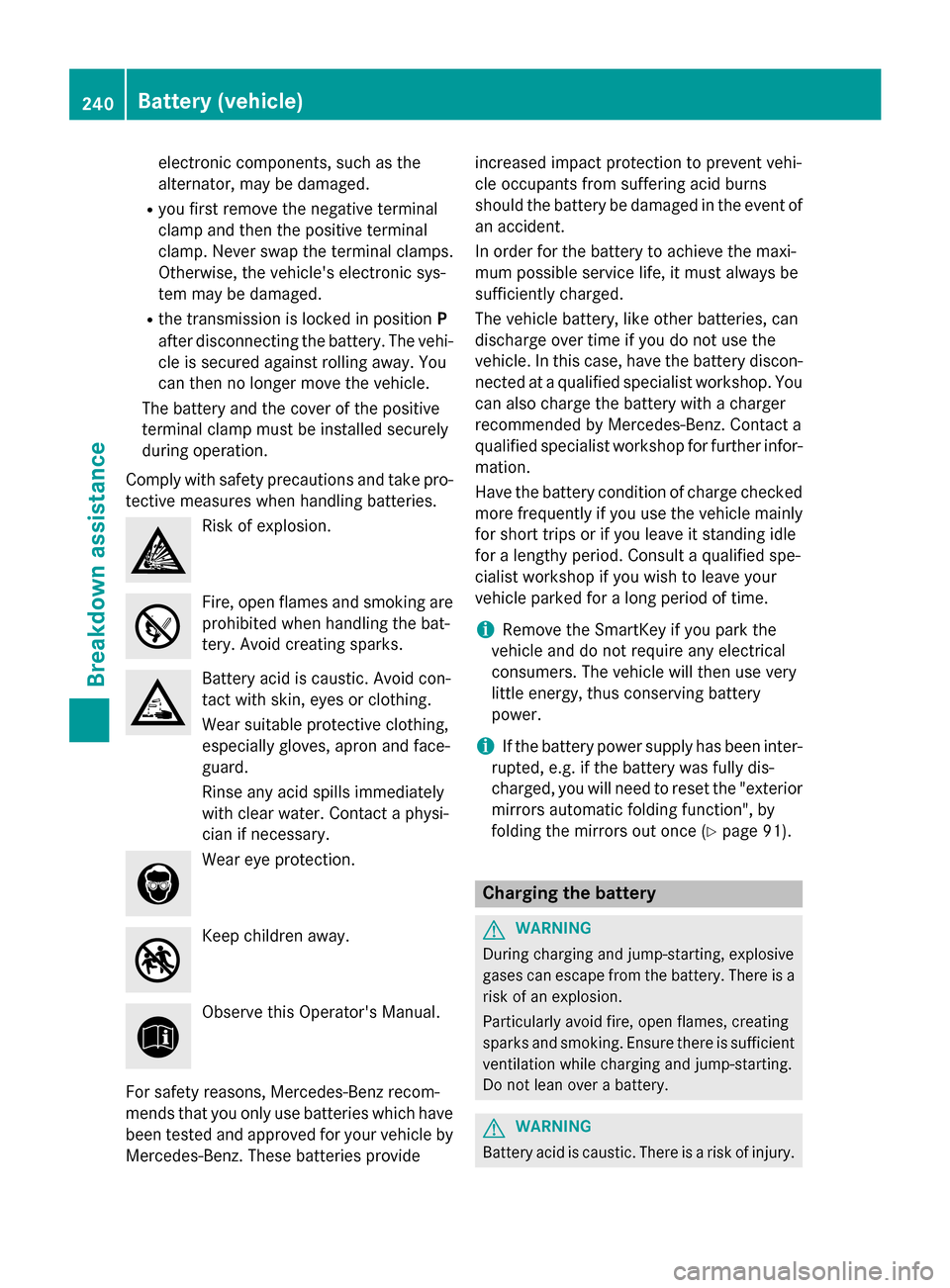
electronic components, such as the
alternator, may be damaged.
R you first remove the negativ eterminal
clamp and then the positive terminal
clamp. Never swap the terminal clamps.
Otherwise, the vehicle's electronic sys-
tem may be damaged.
R the transmission is locked in position P
after disconnectingt he battery. The vehi-
cle is secured against rolling away. You
can then no longer move the vehicle.
The batter yand the cover of the positive
terminal clamp must be installed securely
during operation.
Comply with safety precaution sand take pro-
tective measures when handling batteries. Risk of explosion.
Fire, open flames and smoking are
prohibited when handling the bat-
tery. Avoid creating sparks. Battery acid is caustic
.Avoid con-
tact with skin ,eyes or clothing.
Wear suitable protective clothing,
especially gloves, apron and face-
guard.
Rinse any acid spills immediately
with clear water. Contac taphysi-
cian if necessary. Wear eye protection.
Keep children away.
Observe this Operator's Manual.
For safety reasons, Mercedes-Benzr ecom-
mends that you only use batteries which have been tested and approved for your vehicle by
Mercedes-Benz. These batteries provide increased impact protection to preven
tvehi-
cle occupants from sufferin gacid burns
should the batter ybedamaged in the event of
an accident.
In order for the batter ytoachieve the maxi-
mum possible servic elife, it must alway sbe
sufficiently charged.
The vehicle battery, like other batteries, can
discharge over time if you do not use the
vehicle. In this case, have the batter ydiscon-
nected at aqualified specialist workshop. You
can also charge the batter ywithacharger
recommended by Mercedes-Benz. Contac ta
qualified specialist worksho pfor further infor-
mation.
Have the batter ycondition of charge checked
more frequently if you use the vehicle mainly
for short trips or if you leave it standing idle
for alengthy period. Consult aqualified spe-
cialist worksho pifyou wish to leave your
vehicle parked for along period of time.
i Remove the SmartKey if you park the
vehicle and do not require any electrical
consumers. The vehicle will then use very
little energy, thus conservin gbattery
power.
i If the batter
ypower supply has been inter-
rupted, e.g. if the batter ywas fully dis-
charged, you will need to reset the "exterior
mirror sautomatic folding function", by
folding the mirror sout once( Ypage 91). Charging the battery
G
WARNING
Durin gchargin gand jump-starting, explosive
gases can escape from the battery. There is a risk of an explosion.
Particularly avoid fire, open flames, creating
sparks and smoking. Ensure there is sufficient
ventilation while chargin gand jump-starting.
Do not lean over abattery. G
WARNING
Battery acid is caustic .There is arisk of injury. 240
Battery (vehicle)Breakdown assistance
Page 243 of 290
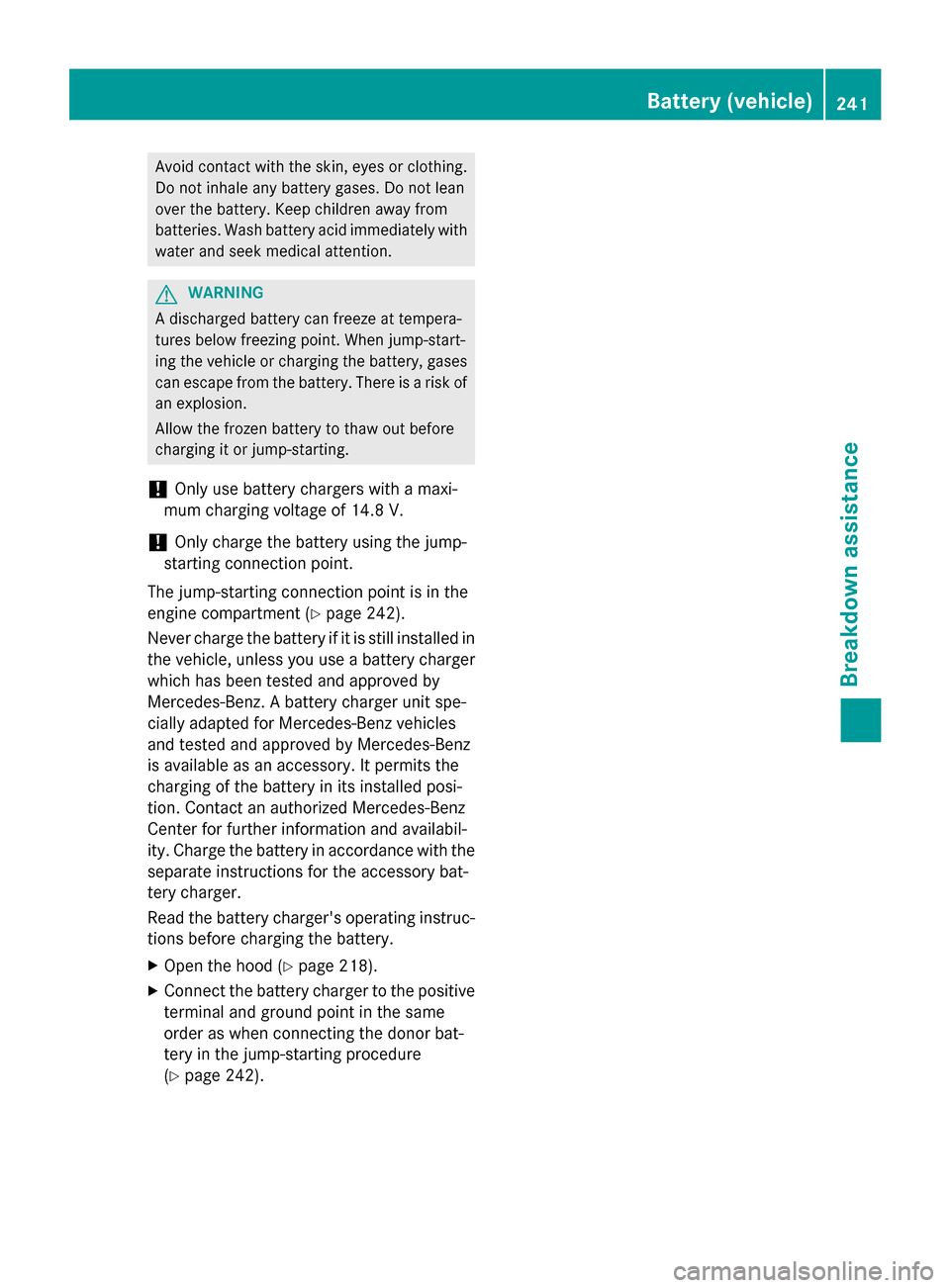
Avoi
dcontact with the skin, eyes or clothing.
Do not inhal eany battery gases .Donot lean
ove rthe battery .Keepc hildren away from
batteries. Wash battery aci dimmediatel ywith
water and see kmedica lattention. G
WARNING
Ad ischarge dbattery can freeze at tempera-
ture sbelow freezing point. Whe njump-start-
ing the vehicl eorcharging the battery ,gases
can escap efrom the battery .There is ariskof
an explosion.
Allow the froze nbattery to tha woutbefore
charging it or jump-starting.
! Onl
yusebattery chargers with amaxi-
mu mc harging voltag eof14.8V.
! Only
charge the battery using the jump-
starting connection point.
The jump-starting connection point is in the
engine compartment (Y page 242).
Neve rcharge the battery if it is stil linstalled in
the vehicle ,unless yo uuseab attery charger
which ha sbeent ested and approved by
Mercedes-Benz. Abattery charge runits pe-
ciall yadapt ed for Mercedes-Benz vehicles
and tested and approved by Mercedes-Benz
is available as an accessory. It permits the
charging of the battery in its installed posi-
tion. Contact an authorized Mercedes-Benz
Center for further information and availabil-
ity .C harget he battery in accordance with the
separate instructions for the accessory bat-
tery charger.
Read the battery charger's operating instruc- tions before charging the battery.
X Ope nthe hoo d(Ypage 218).
X Connect the battery charge rtothe positive
terminal and ground point in the same
order as when connecting the dono rbat-
tery in the jump-starting procedure
(Y page 242). Battery (vehicle)
241Breakdown assistance Z
Page 244 of 290
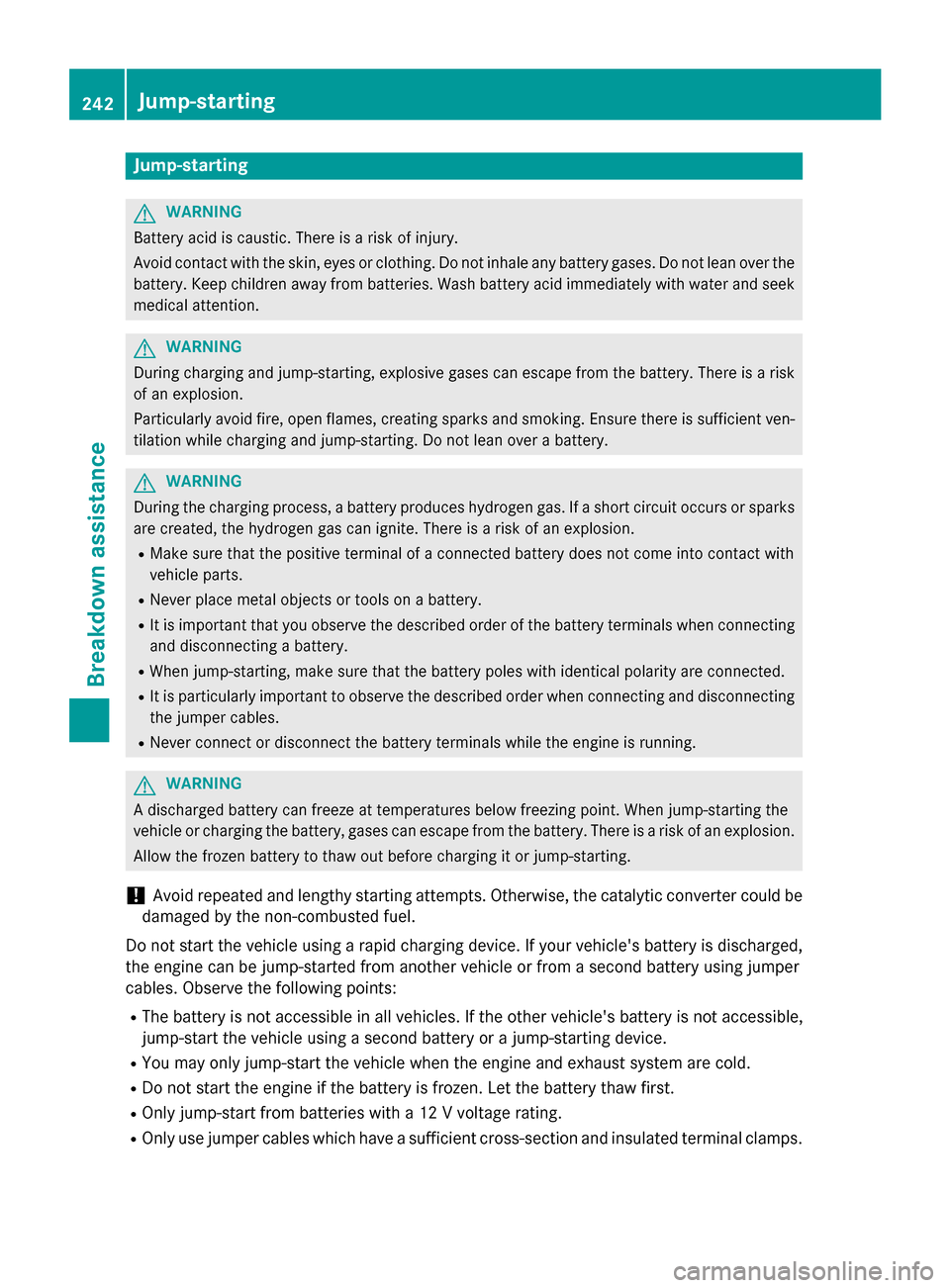
Jump-starting
G
WARNING
Battery acid is caustic. There is arisk of injury.
Avoid contact with the skin, eyes or clothing. Do not inhale any battery gases. Do not lean over the battery. Keep children away from batteries. Wash battery acid immediately with water and seek
medical attention. G
WARNING
During charging and jump-starting, explosive gases can escape from the battery. There is arisk
of an explosion.
Particularly avoid fire, open flames, creating sparks and smoking. Ensure there is sufficient ven-
tilation while charging and jump-starting. Do not lean over abattery. G
WARNING
During the charging process, abattery produces hydrogen gas. If ashort circuit occurs or sparks
are created, the hydrogen gas can ignite. There is arisk of an explosion.
R Make sure that the positive terminal of aconnected battery does not come into contact with
vehicle parts.
R Never place metal objects or tools on abattery.
R It is important that you observe the described order of the battery terminals when connecting
and disconnecting abattery.
R When jump-starting, make sure that the battery poles with identical polarity are connected.
R It is particularly important to observe the described order when connecting and disconnecting
the jumper cables.
R Never connect or disconnectt he battery terminals while the engine is running.G
WARNING
Ad ischarged battery can freeze at temperatures below freezing point. When jump-starting the
vehicle or charging the battery, gases can escape from the battery. There is arisk of an explosion.
Allow the frozen battery to thaw out before charging it or jump-starting.
! Avoid repeated and lengthy startinga
ttempts. Otherwise, the catalytic converter could be
damaged by the non-combusted fuel.
Do not start the vehicle using arapid charging device. If your vehicle's battery is discharged,
the engine can be jump-started from another vehicle or from asecond battery using jumper
cables. Observe the following points:
R The battery is not accessible in all vehicles. If the other vehicle's battery is not accessible,
jump-start the vehicle using asecond battery or ajump-starting device.
R You may only jump-start the vehicle when the engine and exhaust system are cold.
R Do not start the engine if the battery is frozen.L et the battery thaw first.
R Only jump-start from batteries with a12Vvoltage rating.
R Only use jumper cables which have asufficient cross-section and insulated terminal clamps. 242
Jump-startingBreakdown assistance